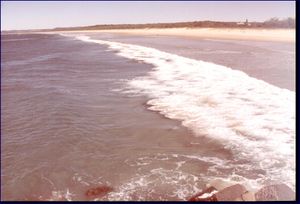Difference between revisions of "Coastal zone characteristics"
(→Sandy beaches) |
(→Barrier coasts) |
||
| Line 29: | Line 29: | ||
===Barrier coasts=== | ===Barrier coasts=== | ||
[[Image:barrier coast.jpg|thumb|barrier coast]] | [[Image:barrier coast.jpg|thumb|barrier coast]] | ||
| − | Barrier islands [[ | + | Barrier islands (see [[Media:Barrier.jpg|diagram]]) are parallel to the shore, separated from mainland by a lagoon. In a profile with a more gentle slope than the equilibrium profile, sediments will be moved onshore, as waves on the shoreface will primarily transport sand towards shore attempting to build up equilibrium profile. Waves lose their energy over the gentle shoreface and deposition occurs some distance from shoreline --> eventually develops into a barrier island (cross-shore transport). Transport of sand by longshore transport will add to barrier formation, a combination of sand spit and barrier island processes, normally occurring under type 1 and 2 conditions. |
<!--note:link to this type 1 and 2 reference?--> | <!--note:link to this type 1 and 2 reference?--> | ||
Revision as of 15:48, 21 February 2007
This one should be relatively short - with links to more specific entries.
Contents
Different coastal types:
Sandy beaches
Sand is a very common marine sediment and is transported along the shoreline by littoral transport. Sand transport (littoral transport or littoral drift) is driven by the breaking waves and the longshore currents in the wave breaking zone. The appearance of natural Sandy beaches is determined by hydrographic conditions and geology. Any interference will cause a reaction in the form of a shoreline response. Therefore, understanding of physical processes is important and the development of suitable solutions required, supported by numerical modelling if needed.
See also:
- Coastal Hydrodynamics And Transport Processes#Littoral Transport
- Classification of Coastal Profiles
- Shore nourishment
Muddy coasts
Muddy coasts are only found in environments that are fairly calm with respect to wave conditions; or there is abundant supply of fine sediments. They are normally vegetated e.g. mangroves fronted by very flat slopes or tidal flats and a muddy coast with mangrove vegetation is characterized by a muddy shoreface, sometimes in the form of muddy tidal flats, and the lack of a sandy shore. Mud has special properties.
Rocky coasts
Rocky coasts are continuously cut back by the sea and are characterised by erosional features. They have a slow rate of morphological change, and experience the main erosional processes of: mechanical wave erosion, abrasion and hydraulic action; weathering - physical, salt, chemical and water-layer levelling; bio-erosion - biochecmial and biophysical; and mass movements by rock falls and toppling, slides and flows[1].
Arctic coasts
Barrier coasts
Barrier islands (see diagram) are parallel to the shore, separated from mainland by a lagoon. In a profile with a more gentle slope than the equilibrium profile, sediments will be moved onshore, as waves on the shoreface will primarily transport sand towards shore attempting to build up equilibrium profile. Waves lose their energy over the gentle shoreface and deposition occurs some distance from shoreline --> eventually develops into a barrier island (cross-shore transport). Transport of sand by longshore transport will add to barrier formation, a combination of sand spit and barrier island processes, normally occurring under type 1 and 2 conditions.
See also:
- Slapton barrier beach case study, UK
- Origin and Genesis of coastal barriere systems. Case study from Rømø in the Danish Wadden Sea
- Classification of Coastlines#Barrier Islands
See also
References
- ↑ Masselink, G and Hughes, M. 2003. Introduction to Coastal Processes and Geomorphology. Hodder Arnold.
(Caitlin 09:31, 18 January 2007 (Romance Standard Time))


